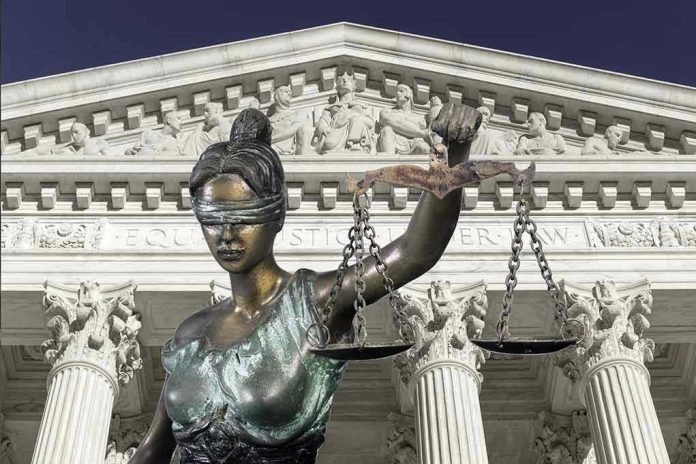
A new policy threatens the balance of power between the President and Congress, sparking a constitutional clash.
Story Highlights
- Supreme Court to decide legality of Trump’s $3 trillion tariffs.
- Lower courts ruled tariffs as unconstitutional overreach of executive power.
- Trump administration argues tariffs are vital for economic security.
- Outcome will set precedent for presidential emergency powers.
Supreme Court to Decide on Trump’s Tariffs
The Supreme Court is poised to make a pivotal decision regarding President Trump’s imposition of tariffs, a move that has been labeled by critics as an illegal $3 trillion tax. These tariffs, enacted under the International Emergency Economic Powers Act (IEEPA), were struck down by lower courts, which argued they overstepped presidential authority by infringing on Congress’s constitutional power to levy tariffs. The case, now set for expedited review, will test the limits of executive power.
In 2024, the Trump administration cited national emergencies, including the U.S. trade deficit and fentanyl trafficking, to justify tariffs on imports from Canada, China, and other nations. By leveraging IEEPA, Trump implemented tariffs ranging from 10% to 50% on a wide range of goods. However, these actions faced immediate legal challenges from small businesses and several states, which argued that the tariffs exceeded presidential powers and were unconstitutional.
Constitutional Limits and Legal Challenges
Historically, the IEEPA has been used to address extraordinary threats to national security, foreign policy, or the economy, typically through sanctions or asset restrictions. Traditionally, Congress has held the authority to regulate tariffs. The current case raises critical questions about the separation of powers and the extent of presidential emergency powers. Previous court decisions have curtailed the broad use of IEEPA for sweeping economic measures, and the Supreme Court’s ruling could redefine these boundaries.
The Trump administration maintains that the tariffs are necessary for national security and economic leverage, warning of severe economic repercussions if the tariffs are nullified. However, the challengers, including small businesses and states, argue that these tariffs cause significant financial harm and undermine constitutional governance. The Supreme Court’s decision will not only affect U.S. trade policy but also set a precedent for future administrations.
Implications and Future Outlook
The Supreme Court’s upcoming decision, scheduled for November 2025, will have far-reaching implications. In the short term, businesses and importers face uncertainty and potential financial strain due to fluctuating tariff rates. If upheld, these tariffs could disrupt trade negotiations and supply chains, impacting U.S. consumers with higher prices. In the long term, the ruling will clarify the scope of presidential emergency powers under IEEPA, potentially reshaping U.S. economic policies and international relations.
Small businesses challenging many of President Trump’s global tariffs urged the US Supreme Court to affirm lower court rulings that the import levies amount to a massive illegal tax on American companies https://t.co/eY7IoLbOOY
— Kathleen Wailes (@kmwailes1) October 21, 2025
The decision will also influence the balance of power between the executive and legislative branches, particularly concerning tariff policies. The outcome is eagerly anticipated not only by businesses and states directly affected but also by legal scholars and policymakers who see this case as a landmark moment in the interpretation of executive authority.
Sources:
Supreme Court agrees to decide the fate of Trump’s tariffs
The Supreme Court’s decision on Trump tariffs will have lasting impact on U.S. economic statecraft
Trump warns US will struggle for years if Supreme Court rules against him on tariffs

















